The right choice: a practical study of the cognitive abilities of great apes

What is common between a mop, a desk, a car and the Hubble telescope? All of this is different in terms of the complexity of implementation, and in the purpose of application, and in the importance of things. However, they can be combined into one general category - tools. We, people, use all these subjects as an aid in achieving one or another goal: cleanliness in the apartment, convenient writing of the article, reduction of time to go from point A to point B, satisfaction of unlimited curiosity and thirst for knowledge in the form of space exploration. and is one of the characteristic signs of developed intelligence. But an even more important indicator of the presence of convolutions in the head is the ability to choose, in particular, choose the appropriate tool if it is needed. You will not wash the floor with a shovel. And not because it will look strange, but because it is inconvenient. In other words, achieving the goal of a clean floor will be overly complicated due to choosing the wrong tool.
A person is able to make a profitable choice for himself, but what is the situation with this skill in great apes? The answer to this question was decided to find by scientists who conducted a series of tests with the participation of "forest people", that is, orangutans. Whether they are able to choose more favorable conditions and more convenient tools or not, we learn from the report of the research group. Go.
')
The basis of the study
For animals living in their natural environment, food has always been a major daily task. Weather and seasonal changes, habitat and gastronomic preferences are factors that influence the difficulty of obtaining food and its quality. Sometimes for getting food it is not enough just to pick a ripe, tasty fruit from the ground. Sometimes you need to be smart and use a tool for its extraction. No matter how simple such an action may seem, not all animals are capable of it. And here we can understand that with food abundance, such animals are unlikely to use tools, spending more time on food. But when food is scarce, and most of it cannot boast of good quality (rotten or unripe fruit, for example), you need to spend more time and effort if you want to eat something tasty and ripe.

And then there is the concept of choice: there is something lying on the ground for a week and does not look particularly attractive, or think about it, spend more time and energy, but get the best. Orangutans and in this aspect can be called unique, because they are able to make a choice. Few have this talent: some species of monkeys, dogs, crows, parrots, and a few other animals with sufficiently developed intelligence.
According to the scientists themselves, to this study, they were quite aroused by specific orangutans living in the peat bog forests of Central Kalimantan (Indonesia). The fact is that in this region unpredictable weather and seasonal conditions lead to an uneven distribution of ripe fruit (both in territory and in time). In some periods of the year only 3% of all fruits are ripe. Therefore, orangutans have to use all their intellectual and climbing abilities for their prey.
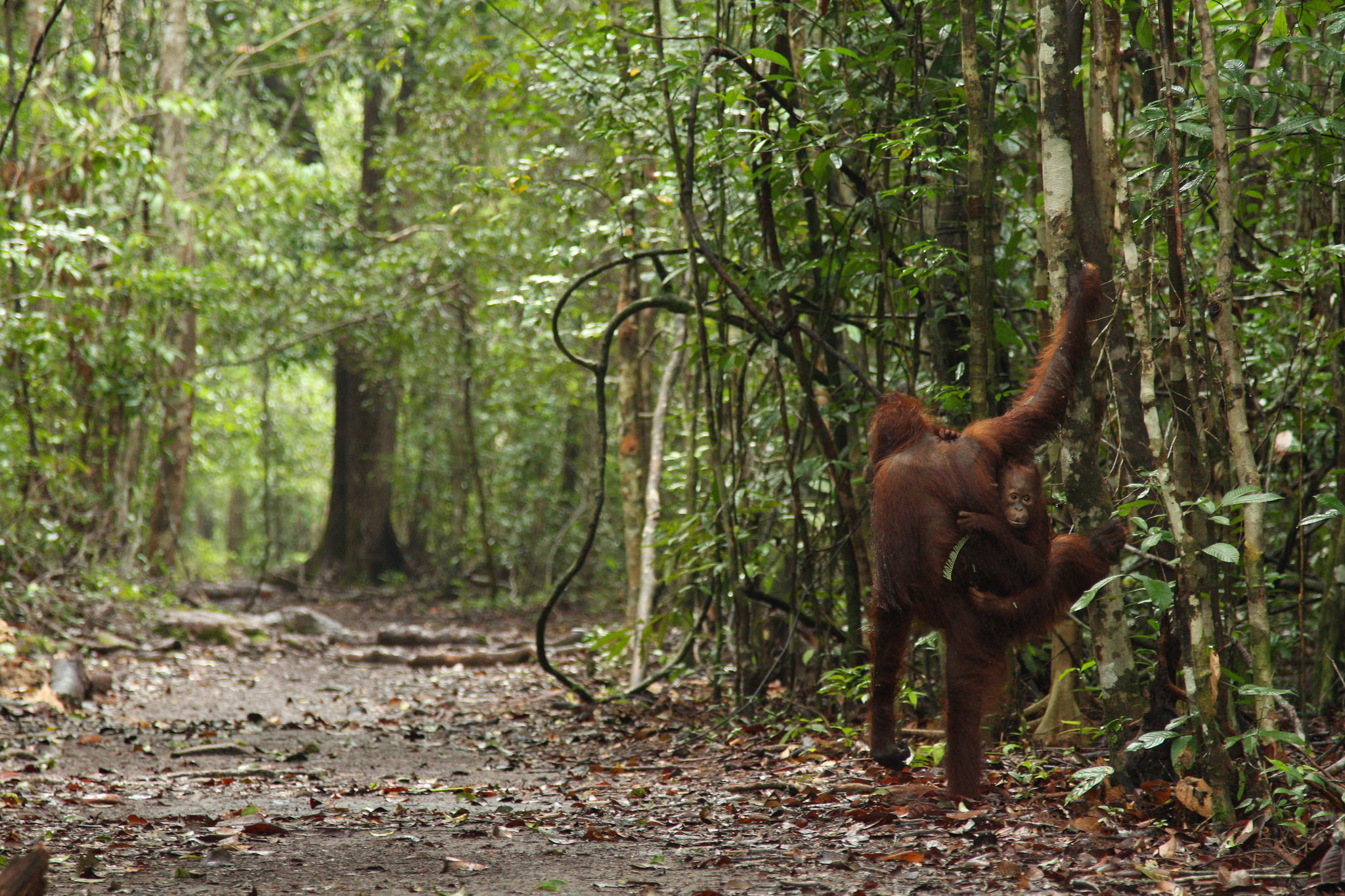
Forests of Central Kalimantan
Observations on the orangutans of Central Kalimantan showed that they are not lazy, preferring to use the tools to get so rare ripe fruit, and do not eat anything.
Scientists, naturally, cannot take such behavior of monkeys for granted, so they decided to conduct a series of tests that were once used to test the ability to choose the cockatoo Goffin. Both the orangutans and the cockatoo live in roughly the same conditions in the wild, therefore they may face similar difficulties in the process of food extraction, therefore this test is quite universal.
At its core, tests are to test the ability of an animal to choose between instantly available low / high quality food and food (also low / high quality) within a device, which can only be reached using a tool that must also be selected.
Test preparation
The main participants of the test were 6 individuals of orangutans: 4 adult females, 1 adult male and 1 young male. All individuals were born in the walls of the zoo Leipzig (Germany), namely in the center of the study of primates named Wolfgang Köhler. All their lives, these orangutans were socialized, that is, they lived in groups in an area of 2,000 m 2 (200 m 2 - the interior and 1800 m 2 - under the open sky). In this impressive area there were various designs for climbing, food and water are available on request. A regular feeding was carried out 3 times a day. Simply put, the subjects lived in fairly good conditions, were physically healthy and socially active.

Wolfgang Köhler
The tests used a fairly simple device made of transparent plastic. On top there was a hole for applying the tool (a stick or a ball), using which one could push a small container with goodness to the edge. The food fell down, and the subject was free to get it. Applying one tool to a different type of device was impossible.
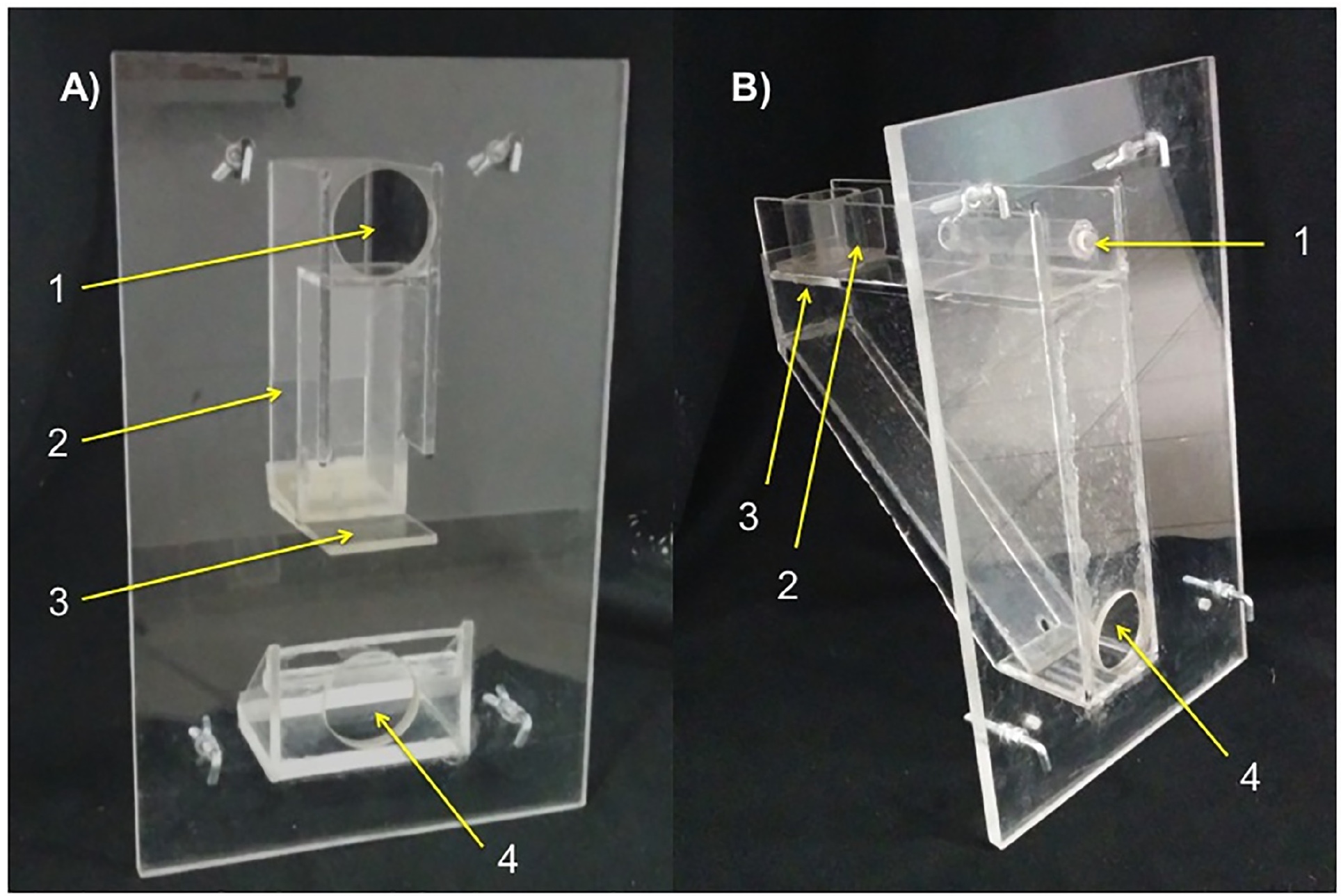
Diagram of two test devices. A: 1 - hole for the use of the tool (ball); 2 - vertical chute, where you need to push the food; 3 - folding panel where food should fall; 4 - a hole for the collection of food (reward). B: hole for the use of the tool (stick); 2 - mobile cube without bottom with food; 3 - hole to the inclined panel; 4 - a hole for the collection of food (reward).
As we can see, the devices are quite simple, which does not prevent them from being quite informative in terms of testing.
Before the tests, each of the individuals was trained from 40 attempts with each of the two devices. During training, the orangutans received the tools and successfully coped with the task (applying a specific tool to a specific device).
Rewards, that is, food, were also carefully selected among the most favorite monkey delicacies (apples, grapes and banana pellets). Two types of products were tested. The most qualitative (further good) was considered to be the one most often preferred by the subjects themselves. As a low-quality (further bad) made option, which was chosen the least number of times. As a result, the product “banana pellets” became good, which monkeys chose in 90% of cases. An apple for the dough was a bad choice. For the only adult male, a banana (a good option) and grapes (a bad option) were used in the test.
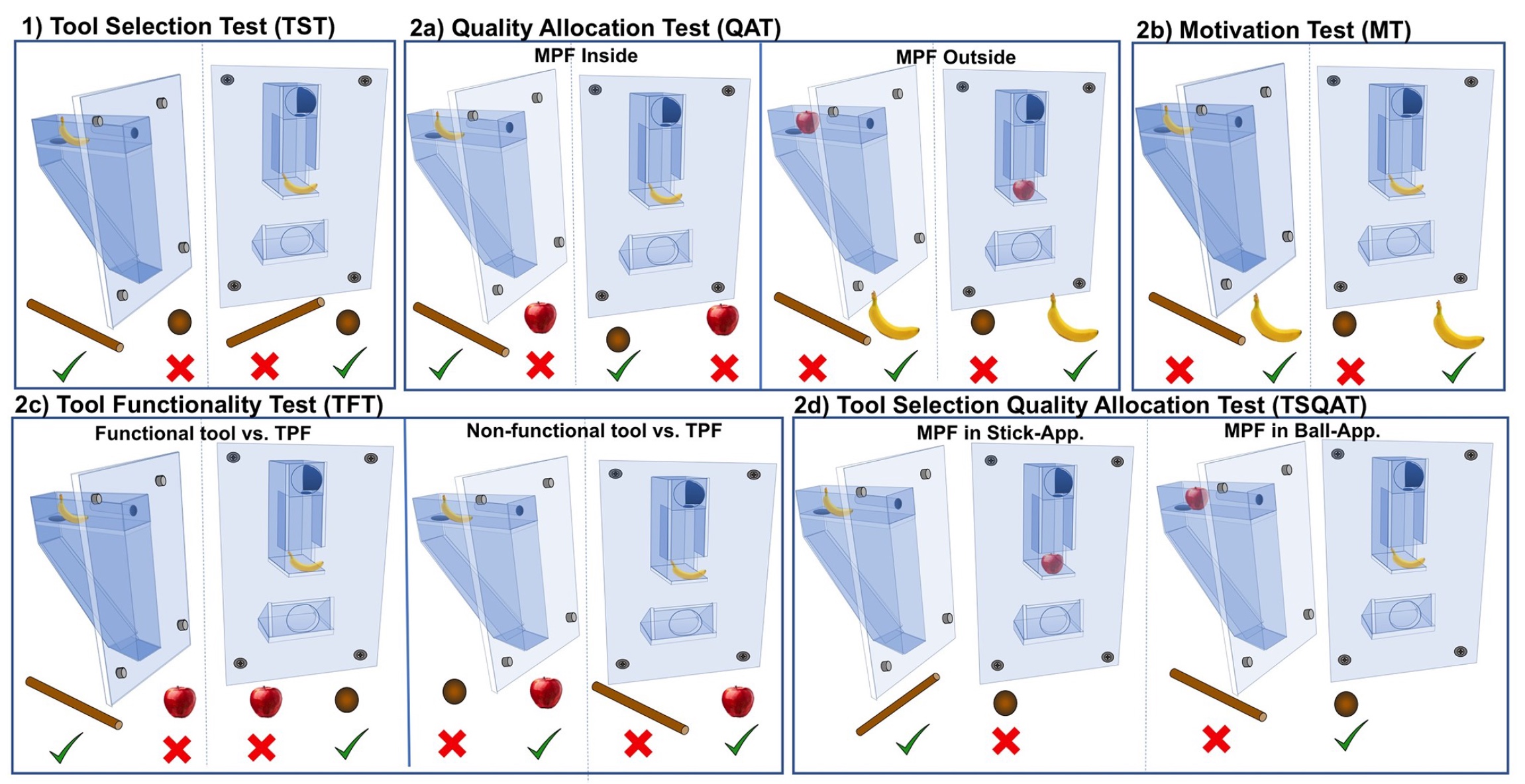
And finally, the tests themselves, of which there were 5: the choice of instrument, the determination of the quality of remuneration, the motivation, the functionality of the instrument and the mixed test for the choice of instrument and the determination of the quality of remuneration. About each test and the results below.
Test tool selection
In this test (image above №1 ), as is clear from its name, the subjects had to choose the right tool for a particular device in order to get a reward inside it. This test, as scientists themselves confirm, was carried out to a greater extent so that the subjects received a sufficient amount of knowledge and understanding of the operation of the device. Orangutans could pass this test as many times as necessary (in 1 approach 12 attempts), until their indicator of correct choice reaches about 83%.
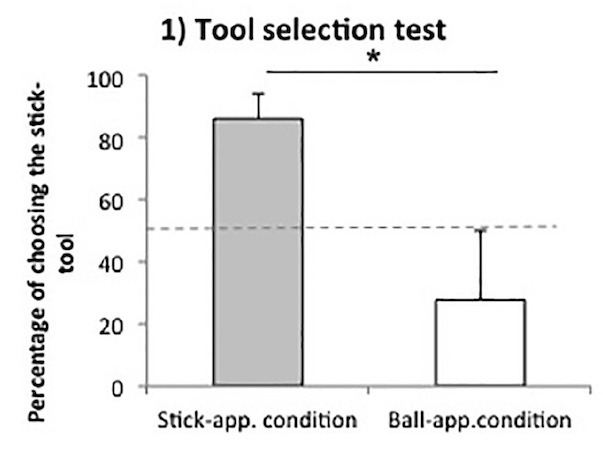
Above is a graph of the results of this test. It is interesting that the test subjects chose the stick more often when the device corresponded to this tool than the ball for the corresponding device (T + = 21, p = 0.031). Five of the 6 subjects practically always correctly chose a stick for the corresponding device, three of 6 had a ball for the corresponding device (p <0.05). However, the three subjects (names: Dokana, Suaq, Bimbo) took up to 7 runs of 12 attempts each to achieve a similarly high result.
Obviously, there is not much difference in the test results when using different devices (Wilcoxon test: p> 0.05). Also, there were no significant differences in the degree of learning between the first six attempts and the last six. This suggests that the type of device and the number of attempts (during preparation) can in no way affect the study and the results of testing the main task - the choice.
Quality Definition
In this test ( 2a ), the researchers wanted to find out how well the subjects understand the position of good and bad reward options and two types of tools. There were two versions of the test conditions: a good version of the food inside the device or outside the device. That is, half the time inside the device was a bad or good option. The subjects had to choose either a bad option (just pointing the finger at it), or a good one, for which it was necessary to use the tool. There were a total of 4 options for combinations, given the type of device and the quality of remuneration. For each option, 12 tests were conducted with each of the subjects.

The graph above shows the percentage of subjects who chose to choose a tool depending on the position of a good reward option. An individual analysis of the results of the subjects showed that 5 out of 6 orangutans chose the tool much more often when the best reward was inside the device than when it was outside (Fisher's exact test: p <0.001). Only an orangutan by the name of Bimbo distinguished himself, who only once chose a tool from 24 attempts, and then when a good reward was already outside.
Motivation test
At this stage ( 2b ), the researchers decided to conduct a rather interesting test with both installations. In front of the subjects there were installations with banana pellets (that is, with a good reward option) inside, and outside there was a necessary tool and another banana pellet. Simply put, there was a choice before the orangutan: use the tool and get a good reward, or do nothing and still get the same reward. As previously, 2 runs of 12 attempts were made for each subject.

In accordance with the schedule of test results, most of the attempts ended with the choice of just a good reward from the outside, rather than a tool to get the same reward inside the installation (T + = 12, p = 0.844). Considering each subject individually, the scientists noted that 4 out of 6 almost always chose an affordable reward, and 2 out of 6 preferred the tool (binomial test: p <0.05).
However, most of the subjects still understood that there is no need to expend additional efforts to get a good reward, if the same lies right in front of them.
Tool functionality test
This test ( 2c ) was aimed at checking how the subjects would behave if they were faced with the following choice: the wrong tool or a poor reward. That is, they can use the tool, but it does not fit a particular installation, because they will not receive a good reward no matter how much they try. But they can get an affordable bad reward that lies outside the installation. A total of 4 visits were made on 12 attempts.

In half the attempts (in random order) the tool was non-functional. In cases where the right tools and the poor reward were located in front of the subjects, the majority chose the tool, wanting to get good inside the device. The graph above confirms this (T + = 15; p = 0.063). Four of the six orangutans chose the tool (functional), rather than the poor reward, more often than others (Fisher's exact test: p <0.05).
Test tool selection and reward location
This test ( 2d ) is considered the most difficult, because all the possible elements from all previous tests are presented to the subjects: both installations, two types of reward (inside / outside) and two types of tools. Scientists organized two basic options: in both installations there was a reward (good in one and bad in the other), subjects for 15 seconds could familiarize themselves with the installations, and then make a decision (they had to choose the appropriate tool to get what they wanted) for not more than 9 seconds There were 2 runs of 12 attempts for each test orangutan.
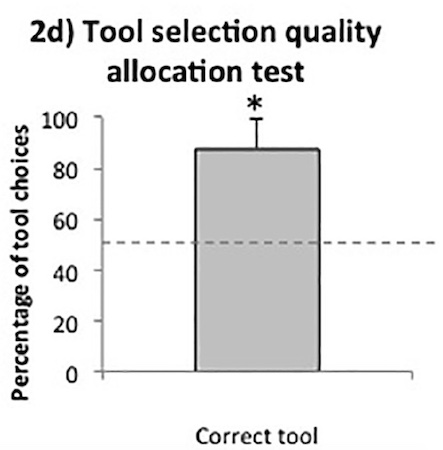
More than 80% of attempts ended with the choice of the tool that allows you to get just a good reward from the installation, and not a bad one (T + = 21, p = 0.031).
In this video, we can personally see all the test options.
The findings of researchers
Summarizing all the test results, scientists summarize - the overwhelming majority of attempts ended with the choice of the most profitable option. If the subjects had a choice between a good reward inside the plant and a bad one outside, they chose the first one and used the right tool to get it. However, they did not choose the tools when the quality of the reward in the installation was worse (or the same) than the reward outside. If before the orangutans were both installations, they continued to choose the best option for them, namely, using the necessary tools for working with the appropriate installation and to get a good reward.
The researchers note that these results are very different from those demonstrated by other subjects - parrots. The latter could not concentrate on the most advantageous variant in the mixed test (2 installations, 2 tools and 2 types of reward inside / outside). Also, scientists note that female orangutans coped with this test better than males. Previously, such conclusions were already made from similar tests, but there were at least one type of set-up in front of the test subjects on different testing days, although there were different types of setups. In the same study, the difficulty lay precisely in the presence of two installations at once before the monkeys.
Of the entire group of subjects, two individuals stand out - an adult male Bimbo (1980 born) and an 8-year-old male Sak (2009 born). Despite good performance, Bimbo did the best job with tests, where he needed a ball as a tool. This is due to the fact that earlier Bimbo had already participated in similar studies, and it was the ball that was used there. Sak also chose the best option for himself in all tests at the level of randomness. They needed 7 additional visits during the preparation for the tests to achieve the minimum criterion of results.
According to the observations of Christoph J. Völter and Joseph Call (Josep Call), the number of successful attempts at chimpanzees, bobans and orangutans is significantly reduced if they are put in front of several installations at the same time. That is, they cannot cope with two simultaneous spatial relations object-object (instrument-reward and reward-installation). According to scientists, this is due to the cognitive overload of the attention of the subjects.
However, in this study, this fact is refuted by the success of mixed tests performed by orangutans, when they consciously and quickly enough could make the most advantageous decision for themselves if they had two installations at once, two types of tools and rewards.
For more detailed acquaintance with the study I strongly recommend to look into the report of scientists and additional materials to it.
Epilogue
The ability to use tools, as well as the ability to choose a profitable option, are not something surprising in the world of people. We are faced with the need to apply these skills every day. Even an ordinary trip is fraught with a choice: you can take the subway, or you can take a taxi, or you can take a bike or even walk. We take into account all factors (as far as we are in a hurry, where exactly we need to get to, what is the situation on the roads, etc.) and make the best choice for us.
But in the animal world, such skills are rare and indicate the presence of a sufficiently developed intellect, which greatly helps them to survive in an unfavorable environment, when weather conditions, the lack of quality food or the presence of competitors for its prey can have a very negative impact on life.
And, of course, Friday offtop:
Our beloved (at least mine) David Attenborough talks about the unusual abilities of orangutans.
Our beloved (at least mine) David Attenborough talks about the unusual abilities of orangutans.
Offtop 2.0 (it was impossible not to recall this in this article):
An excerpt from the classics of world cinema (Space Odyssey 2001, 1968, directed by Stanley Kubrick).
An excerpt from the classics of world cinema (Space Odyssey 2001, 1968, directed by Stanley Kubrick).
Thank you for your attention, stay curious and have a good weekend, guys.
Thank you for staying with us. Do you like our articles? Want to see more interesting materials? Support us by placing an order or recommending to friends, 30% discount for Habr users on a unique analogue of the entry-level servers that we invented for you: The whole truth about VPS (KVM) E5-2650 v4 (6 Cores) 10GB DDR4 240GB SSD 1Gbps from $ 20 or how to share the server? (Options are available with RAID1 and RAID10, up to 24 cores and up to 40GB DDR4).
VPS (KVM) E5-2650 v4 (6 Cores) 10GB DDR4 240GB SSD 1Gbps until spring for free if you pay for a period of six months, you can order here .
Dell R730xd 2 times cheaper? Only we have 2 x Intel Dodeca-Core Xeon E5-2650v4 128GB DDR4 6x480GB SSD 1Gbps 100 TV from $ 249 in the Netherlands and the USA! Read about How to build an infrastructure building. class c using servers Dell R730xd E5-2650 v4 worth 9000 euros for a penny?
Source: https://habr.com/ru/post/441128/
All Articles